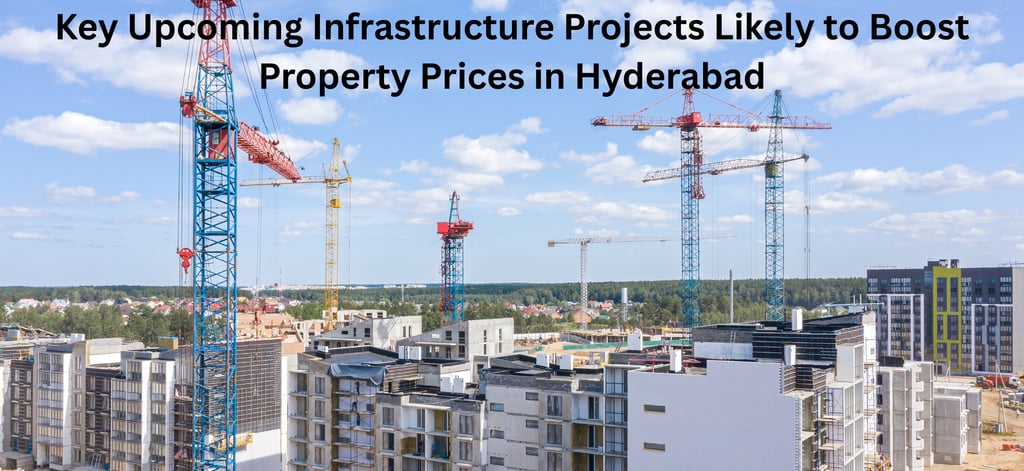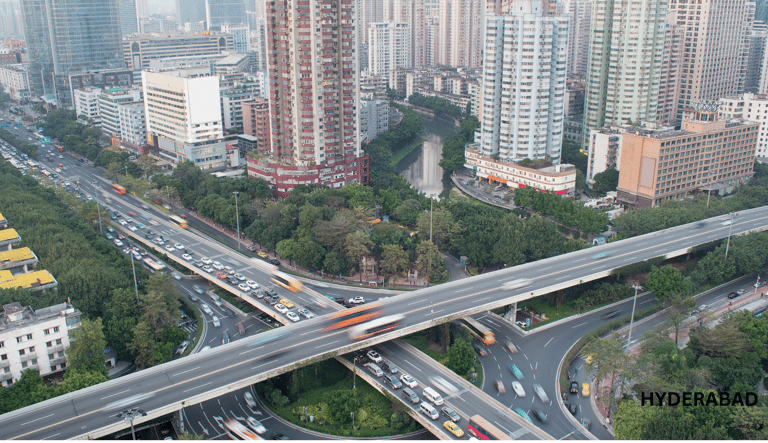Upcoming Infrastructure Projects Likely to Boost Property Prices in Hyderabad
The state has advanced Phase-II with multiple new corridors totalling ~76 km, with a project cost guidance around ₹24,269 crore and a state/centre/debt funding mix. Key proposals include airport and northern extensions (JBS–Medchal; JBS–Shamirpet), along with Neopolis/Kokapet and Nagole–RGIA connectivity. Recent government actions include Phase-II(B) submissions to the Centre and HAML kicking off utility mapping—an early but concrete step before construction.
FLIXAH DEVELOPERS
8/20/20255 min read


Upcoming Infrastructure Projects Likely to Boost Property Prices in Hyderabad
1) Hyderabad Metro Rail Phase-II (plus Airport connectivity)
Why it matters: Rail capacity and coverage are the most reliable long-run drivers of end-user demand and developer activity. New stations typically pull rental demand first, then capital values (pre-launch → launch → possession).
What’s coming: The state has advanced Phase-II with multiple new corridors totalling ~76 km, with a project cost guidance around ₹24,269 crore and a state/centre/debt funding mix. Key proposals include airport and northern extensions (JBS–Medchal; JBS–Shamirpet), along with Neopolis/Kokapet and Nagole–RGIA connectivity. Recent government actions include Phase-II(B) submissions to the Centre and HAML kicking off utility mapping—an early but concrete step before construction. (MagicBricks, HMRL, X (formerly Twitter), The New Indian Express)
Property impact lens:
Micromarkets to watch: LB Nagar–Nagole belt, Kokapet/Neopolis, Kompally/Medchal axis, and airport-facing southern suburbs (Shamshabad–Maheshwaram).
Who benefits first: Projects within ~1–1.5 km of announced/likely station boxes; landowners along station-feeder roads; rental-yield hunters near employment hubs (Raidurg–Gachibowli) that gain direct metro links.
Risks: Approvals, funding cadence, and right-of-way acquisition can stretch timelines; premium already priced in at some IT-proximate nodes.
2) Hyderabad Airport Metro Express & RGIA Expansion
Why it matters: Airport access time is a premium variable for CXOs, IT/ITES, pharma, and GCC talent—reducing friction for business travel and high-frequency flyers. Airport capacity expansions also correlate with hospitality, retail, and logistics upticks.
What’s coming:
Airport Metro Express: Planned ~31 km from Raidurg to RGIA; state-funded EPC model with DPR work and approvals moving through formal channels. (Wikipedia, The Times of India)
RGIA Expansion: Ratings agencies and public disclosures indicate the airport is scaling around the 34-million passengers per annum mark, with further capex lined up in the outer years—an indicator of sustained traffic growth and ancillary development appetite. (Fitch Ratings, India Ratings, CRISIL)
Property impact lens:
Micromarkets to watch: Shamshabad, Mamidipally, Rajendranagar, Budvel, Narsingi, Financial District spillovers.
Asset classes: Mid-to-upper mid residential close to express corridors; last-mile warehousing; hospitality near interchange nodes.
Risks: Phasing—rail commissioning often lags road-based access upgrades; buy with a 5–8 year horizon.
3) Regional Ring Road (RRR)
Why it matters: Rings redistribute growth by unlocking cheaper periphery land and cutting cross-regional travel times. They are powerful in shifting city form, catalysing logistics parks, integrated townships, and price discovery across new nodes.
What’s coming: A 330–340 km access-controlled ring connecting Sangareddy, Toopran, Choutuppal, Amangal, Shankarpally, and more. Status varies by arc; DPR work and preparatory processes continue, with NHAI-led execution in scope. Expect staggered land acquisition and phased packages. (The Metro Rail Guy, Regional Ring Road)
Property impact lens:
Micromarkets to watch: Chevella–Shankarpally–Sangareddy belt (west/north-west), Amangal–Kandukur–Choutuppal (south/east) for plotted development and township-scale plays; logistics along highway junctions.
Who benefits first: Landholders with clear titles along interchanges; early-stage plotted developers with internal road/amenity delivery capability.
Risks: Alignment adjustments, land costs, and environmental clearances can push timelines; avoid overpaying on speculative “announcement premiums.”
4) Strategic Road Development Plan (SRDP) & Elevated Corridors
Why it matters: Flyovers, underpasses, and junction upgrades shrink commute times today, not just tomorrow. This sustains absorption in already-livable suburbs and supports brownfield densification.
What’s coming: Continued SRDP packages across eastern and western corridors (e.g., Uppal, LB Nagar, Miyapur–Bachupally, Narapally), improving east-west permeability and feeder connectivity into ORR/arterials. (Multiple city releases and project lists are in circulation; pair this with on-ground due diligence.)
Property impact lens:
Micromarkets to watch: Uppal–Nagole–LB Nagar (eastern affordability corridor), Miyapur–Bachupally (north-west price-value pocket), and Kokapet–Narsingi (premium IT belt) for near-term liveability gains.
Risks: Construction externalities at junctions; check phasing to avoid near-term access pain during possession years.
5) Musi River Rejuvenation & “Brand Hyderabad” Vision
Why it matters: Waterfront regeneration and flood-mitigation investments lift liveability scores, reduce risk premiums (insurance/monsoon disruptions), and create new leisure-retail-residential frontages—think differentiated urban districts over time.
What’s coming: The state is positioning a Musi rejuvenation push and broader “TelanganaRising-2047” blueprint, which includes green corridors, new highways, metro growth, and logistics/industrial linkages. Expect multi-agency phasing and a long build-out horizon. (The Times of India)
Property impact lens:
Micromarkets to watch: River-adjacent precincts where flood risk is actively mitigated and promenades/greenways are planned; brownfield redevelopment sites that gain resilience infrastructure.
Risks: Inter-departmental coordination and resettlement; watch detailed DPRs and not just vision statements.
6) Industrial/Knowledge-City Pivot: From Pharma City to “Future City” (status fluid)
Why it matters: Large industrial townships anchor job creation. Whether pharma, electronics, or AI hubs—employment density drives leasing, upgrades, and eventually ownership demand.
What’s happening: The previous Hyderabad Pharma City blueprint faces policy churn; the present administration has spoken of repurposing to a multi-sector “Future City,” which is now entangled in legal and political contestation. Investors should treat this cluster as scenario-based, not deterministic, until clarity emerges on land use, approvals, and anchor tenants. (The Times of India, The Economic Times)
Property impact lens:
Micromarkets to watch (if clarified positively): Mucherla–Adibatla–Maheshwaram and Kandukur–Yacharam belts.
Risks: Litigation, land-use shifts, and timeline slippage; only consider reputed developers with escrowed collections and milestone-linked construction.
Where Could Prices Move First?
Stations and Interchanges: 500 m–1.5 km around confirmed metro station locations and RRR interchanges typically see the earliest booking traction. For end-users, that’s a 10–15 minute last-mile sweet spot.
Feeder Roads Upgrades: Suburbs with SRDP works that cut 10–20 minutes off peak commutes (e.g., eastern corridors) see both rent and capital values firm up faster.
Airport-Facing South-West: As Airport Metro & express links consolidate, Shamshabad–Budvel–Rajendranagar–Narsingi can deepen as a mixed mid/upper-mid belt, complementing the Financial District.
North Growth Spine: JBS–Medchal/Shamirpet proposals support Kompally/Alwal/Medchal warehousing-residential mixes; watch for station confirmations and depot locations.
Practical Playbook for Buyers & Investors
Verify project phase, not just the headline. Ask for DPR reference, utility-mapping/land acquisition status, and tender packages. Early-stage proof points (like HAML’s utility mapping) de-risk timelines. (The New Indian Express)
Map your asset to the catalyst. For metro plays, proximity to stations and pedestrian access matters more than raw distance. For RRR, interchange adjacency (and service roads) beats generic “near RRR” claims.
Prefer developers with delivery muscle. Big city-scale infra breeds copycat launches. Stick to builders with track records in handovers, escrow discipline, and amenities that hold rents (clubhouse, co-work, maintenance quality).
Budget for construction externalities. Flyover or metro-pier work near your site? Bake in 12–24 months of dust/noise and phase your possession accordingly.
5–8 year horizon > quick flip. Hyderabad’s infra cycle is robust but staggered. Let compounding work through job growth plus livability upgrades.
Diversify by corridor. Pair a west/south-west (IT/airport) bet with an east/north-east (value-led) position to balance absorption cycles.
Bottom Line
Hyderabad’s next up-cycle in property values is likely to be led by Metro Phase-II (including Airport connectivity), RRR, SRDP junction upgrades, and airport expansion—with the Musi rejuvenation shaping long-term urban quality. Treat the Pharma City → Future City zone as a high-beta, policy-dependent option until land-use clarity and anchor investments are locked.
fro more updates on real estate investment please do visit our page flixahdeveloperspvtltd.com and you also call us at +91 9100600730


